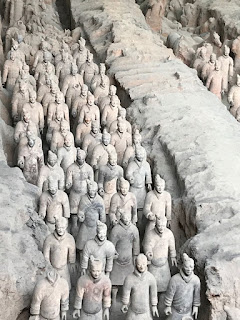Once upon a time… (pt.2) Let’s bury stuff!
 So, now let’s jump head from 1000-500 BC to 200 BC. “Joe’s” dynasty (the Zhou), with all of its
beautiful green pots, has gotten fat and complacent. It expanded, crept east towards the sea.
So, now let’s jump head from 1000-500 BC to 200 BC. “Joe’s” dynasty (the Zhou), with all of its
beautiful green pots, has gotten fat and complacent. It expanded, crept east towards the sea. And suddenly there are signs of a new rebellion coming from Gansu province (which is south and west of Xi’an).

Welcome Qin (pronounced “chin”) dynasty!
See, to understand
China, you really have to recognize its history as a long, cyclical political
game. A group of people stabilize
economically, grow complacent, and then a new group – usually from the west –
steps in. As I daily walk through the
thicket of security cameras monitoring my passage, I think that I understand the
anxiety and paranoia of the current government.
Rebellions are never good for the people in power.
So, who are the Qin?
They were military dudes. They
invested heavily in creating an army that would help unify (or maybe
“re-unify”) China. Their kingdom was into
displays of power and ruthlessness. This
was the emperor who indentured thousands to help him build his wall – linking
various existing city walls into the massive “Great Wall” that we know now. They also were public works dudes. The first emperor to unify currency,
measurements, and created the horribly difficult writing system, that we
struggle with, to this day.
He also commissioned artists from across the country to help
build a massive terracotta warrior army with which he planned to be buried, so
that when he arrived in the afterlife, he could be assured of continuing his
power. Each of the soldiers was signed
by its artist and the artist’s location was indicated. Beware artists: this recognition wasn’t to give the artists
some measure of immortality. It’s
actually a part of quality control. If
you, as an artist, send your terracotta warrior and it is substandard in some
way, historians suspect that you, the artist, would face harsh punishment.


Massive excavation ensued. The floor was lined by handmade bricks. 6000 slightly larger-than- life soldiers were set up in military formation. Each was painted brilliant colors. Each face is different. In the back, behind the military formations, there is a complete war room set up, with guards, horses, chariots. Stone and wood columns were built. These were covered by thatch, and then a roof, and then more dirt to cover the soldiers.

 And then Emperor Qin must have gotten busy. I don’t blame him. In 256, a peasant, Liu Bang, over threw him
and established a new dynasty – the Han dynasty. After that, the Silk Road was
established. Cool stuff was coming in
from the West – like Buddhism in 100 BC.
The long and short of it is, the country forgot about their buried
soldiers. There is no written record of
them. No one mentions them after the
Qins are overthrown. So, I guess that’s irony: you create a massive army to
guarantee you cred in the afterlife, and 50 years later, everyone has forgotten
that it ever existed…
And then Emperor Qin must have gotten busy. I don’t blame him. In 256, a peasant, Liu Bang, over threw him
and established a new dynasty – the Han dynasty. After that, the Silk Road was
established. Cool stuff was coming in
from the West – like Buddhism in 100 BC.
The long and short of it is, the country forgot about their buried
soldiers. There is no written record of
them. No one mentions them after the
Qins are overthrown. So, I guess that’s irony: you create a massive army to
guarantee you cred in the afterlife, and 50 years later, everyone has forgotten
that it ever existed…
…until the public works projects of the 1970s and 80s.
In 1974, a farmer was trying to dig a well and came across a piece of a warrior. He contacted the local government. They started digging… and low and behold, the scope of the discovery became clear. When they uncovered the painted soldiers, the paint almost immediately oxidized and fell off the surface – a metaphor, perhaps, for the fragility of immortality. One thing I didn’t realize is, the entire enterprise is a massive jigsaw puzzle. When the roof caved in eons ago, it shattered most of the army. The archaeologists are daily digging, putting the fragments that they find into a big Styrofoam cooler. Then, they painstakingly piece finger to hand, coat tail to coat, toe to sandal.
(Dave and I are particularly proud of ourselves, because we got to the site (one hour a way) wholly on public transportation!)
In 1974, a farmer was trying to dig a well and came across a piece of a warrior. He contacted the local government. They started digging… and low and behold, the scope of the discovery became clear. When they uncovered the painted soldiers, the paint almost immediately oxidized and fell off the surface – a metaphor, perhaps, for the fragility of immortality. One thing I didn’t realize is, the entire enterprise is a massive jigsaw puzzle. When the roof caved in eons ago, it shattered most of the army. The archaeologists are daily digging, putting the fragments that they find into a big Styrofoam cooler. Then, they painstakingly piece finger to hand, coat tail to coat, toe to sandal.
(Dave and I are particularly proud of ourselves, because we got to the site (one hour a way) wholly on public transportation!)
As a side note: There is a joke circulating.
The question is: why is it taking
so long to build the Xi’an metro. The
answer is this apocryphal series of text messages about the constant finding of
a new tomb or statue as the engineers dig…







Comments
Post a Comment